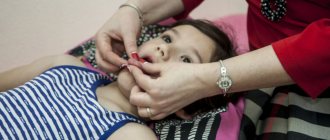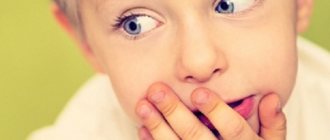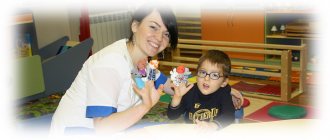Dysarthria is a violation of the pronunciation aspect of speech caused by insufficient innervation of the speech apparatus.
Speech dysarthria can be an independent speech defect, and can also be part of more complex speech disorders.
Violation of sound pronunciation cannot be considered a harmless defect, since it can entail serious negative consequences for the development of the child as a whole. Impaired sound pronunciation makes it difficult for schoolchildren to learn Russian. A child who pronounces sounds incorrectly is often imitated in the children's group, which creates additional psychological problems that can be avoided by teaching him the correct pronunciation in time.
Speech disorders significantly reduce compliance and quality of life. This means that the life of the parents does not improve either.
Causes of dysarthria
Dysarthria in children accompanies cerebral palsy in 65-85% of cases.
In less pronounced forms, it can appear in case of problems that arose during the prenatal period, the birth period, and even during the early development of the child. There are many causes of the disease during pregnancy and childbirth:
- serious toxicosis during pregnancy;
- Rhesus conflict;
- hypoxia;
- the presence of chronic somatic diseases in the mother;
- problems during childbirth - asphyxia, trauma, premature birth, pathologies during childbirth;
- kernicterus of newborns.
After birth, even if no pathologies have arisen in the nervous system in the womb or during childbirth, the risk of developing cerebral palsy still remains. Its appearance can be stimulated by neuroinfections, serious poisoning, trauma, purulent otitis media, and hydrocephalus.
Adults may also experience speech impairment if the brain has been damaged by disease, injury, or tumors. The development of a speech defect is provoked by:
- stroke;
- a brain tumor;
- multiple sclerosis;
- Parkinson's disease;
- myasthenia gravis;
- myotonia;
- neurosyphilis, etc.
Degrees of development of dysarthria
In speech therapy, dysarthria is divided according to the severity of symptoms and the intelligibility of speech for listeners. Thus, experts distinguish 4 degrees of the disease.
1st degree – erased dysarthria. In this case, symptoms are almost not observed and in most cases only a speech therapist can identify them. In children, such disorders are detected at the age of about 5 years. Symptoms of erased dysarthria may include: swallowing or distortion of syllables and sounds, poor diction, and generally inexpressive speech.
2nd degree of dysarthria (typical) – when pronunciation defects are clearly visible, but the speech remains understandable to the listener.
3rd degree (severe) – speech is significantly impaired and can only be understood by loved ones
4th degree – severe speech impairment – complete misunderstanding by others or absolute absence.
Classification
The classification is made according to three types of characteristics - according to the location of the problem in the nervous system, according to the syndrome of cerebral palsy (each of them manifests its own type of deviation) and according to how difficult or easy it is to understand the patient’s speech (the latter is the classification of speech therapists). Let's look at each in order.
Depending on where the source of the problem is located, only 5 types can be distinguished:
- Bulbar dysarthria - in the medulla oblongata there are nuclei of several important cranial nerves that are necessary in the formation of speech: hypoglossal, glossopharyngeal, vagus; when these nerves are affected, speech problems arise. The most pronounced signs are disorders of chewing, swallowing, areflexia, nasalization, and lack of differentiation of sounds among themselves.
- Pseudobulbar – requires differentiation from bulbar; one of the signs is violent crying or laughter. In this case, the corticonuclear pathways are affected. This type of disease is characterized by slurred speech, sonorant, whistling and hissing sounds are pronounced incorrectly. It is difficult for the patient to control the tip of the tongue.
- Cerebellar – the cause is damage to the cerebellum/conducting pathways, as the name implies. There is slow and slurred speech, sounds produced using the lips and the front of the tongue are poorly produced, and isolated cries are observed.
- Cortical – lesions in the cerebral cortex. In this case, only articulatory apraxia is observed.
- Subcortical – similarly associated with damage to the subcortical nuclei. This type can be combined with the first, second and third; it is characterized by articulatory spasms, disturbances in timbre and strength of the voice, and involuntary cries.
According to the leading clinical symptom of cerebral palsy, the following forms of dysarthria are distinguished:
- spastic-rigid,
- spastic-paretic,
- spastic-hyperkinetic,
- spastic-atactic,
- atactico-hyperkinetic.
According to severity, 4 degrees of dysarthria are differentiated, where the first is erased dysarthria (its signs can only be determined by a speech therapist), the second is when speech is understandable, but others notice defects, the third is only relatives who often communicate with the patient can understand him, the fourth (anarthria ) – there is no speech, or it is completely incomprehensible.
Types of dysarthria
Dysarthria divided into types according to the location of the damage, the degree of speech impairment and the defining (most pronounced symptom). Let's look at the most common form of dysarthria.
Bulbar dysarthria - develops as a result of damage to the medulla oblongata. With this form of dysarthria, the connection between the muscles of articulation and the central nervous system is disrupted. As a result, the patient has difficulty managing the correct movements of the tongue and lips, which are in a relaxed state. In general, the face becomes inactive, but there is increased salivation.
Pseudobulbar dysarthria - in more than 80% of cases occurs as a result of ischemic stroke of the brain in people over 50 years of age, or at any age with brain injuries. The disease causes atrophy of the muscles of the speech apparatus, leading to monotony of speech, chewing and swallowing are also difficult, and salivation increases.
Cortical (cortical) dysarthria is a disorder of the frontal cortex as a result of injuries, tumors or previous diseases such as encephalitis or meningitis, as a result of which neurotransmitter functions are partially lost. With this type of dysarthria, the pronunciation of consonants and the rate of speech are disrupted, the automaticity of articulation disappears, and nasal sound appears. Disorders in the frontal gyrus also lead to dysfunction of other muscles in the body, in addition to articulation.
Cerebellar dysarthria is a disorder of speech caused by damage to the cerebellum. This disease is quite rare and most often accompanies other types of dysarthria. Symptoms of disorders of the cerebellum and its connections with other parts of the brain are softness of the palate and tongue, “drunk speech”, chanting of individual sounds or syllables, fading of speech at the end of a phrase, and disturbance of stress.
Symptoms
Dysarthria is a deviation characterized by unclear, incomprehensible, slurred speech due to the fact that the muscles of the soft palate, tongue, larynx, vocal cords, and respiratory muscles function poorly. Defects in the presence of this disease are varied, and many of them overlap with other types of speech disorders, for example, there is a weak, quiet, muffled, nasal voice. Dysarthria is diagnosed based on the following symptoms:
- muscle hypotension;
- muscular dystonia;
- muscle spasticity;
- violations of sound pronunciation - erased dysarthria is characterized by blurred speech, more severe degrees - slow speech, slurring, omission of sounds, distortions, at 4 degrees - absence of speech.
Specific features that manifest dysarthria in children and adults are persistence of defects, learning difficulties, a longer period for automation, violation of both vowels and consonants, interdental and lateral pronunciation of sibilants and sibilants. Illness in children may be accompanied by OHP and dysgraphia.
Symptoms of dysarthria
Dysarthria manifests itself in inarticulate speech, when a person pronounces words inarticulately, as if with a “mouth full”, nasal sound may appear, as with sinusitis, pronunciation of words in syllables with periodic swallowing, disturbances in the rhythm of speech.
Dysarthria is accompanied by increased muscle tone of the speech apparatus, which causes rapid fatigue. The opposite can also occur - hypotension, in which the tongue, lips, cheeks become sluggish, and salivation increases.
With dysarthria, the pronunciation of all sounds, including vowels, suffers, and speech breathing disorders also occur, which affect the intonation and volume of speech.
Diagnostics
Treatment of dysarthria begins with diagnosis, which may involve neurologists and speech therapists. Based on the examination and conversation, a decision is made on the depth of the neurological examination and its plan is formed. The neurological examination is complemented by speech therapy, which includes diagnostics of oral and written speech.
Forms of dysarthria are identified and diagnosed using the following methods:
- electroencephalography;
- electroneurography;
- MRI of the brain;
- electromyography;
- transcranial magnetic stimulation.
The speech therapist, for his part, evaluates non-speech and speech disorders - the structure of the speech organs, the range of possible movements of the tongue, larynx, lips, the condition of the muscles, the nature of breathing. When testing oral speech, a specialist identifies the development of speech according to classical parameters - tempo, intelligibility, synchronization of the three components of a conversation (voice formation, articulation, breathing), sound pronunciation, etc. The written speech test allows you to differentiate the disease you are looking for from several types of speech disorders - dyslalia, motor alalia, motor aphasia.
Prognosis and prevention
The result of treatment depends on the type of disorder and its degree. Regularity of exercise is important. Only constant training and thorough implementation of the doctor’s recommendations will allow you to completely or partially cope with the problem. If we are talking about severe disability, in which dysarthria arose against the background of other pathologies, the likelihood of successful correction is significantly reduced.
Prevention of the disease includes general measures: reducing the risk of injury, a healthy lifestyle during pregnancy, etc.
As soon as you begin to notice the first signs of dysarthria in a preschooler, do not delay your visit to specialists. Only a comprehensive specialized examination will identify or eliminate the problem. At SM-Doctor you will be met by competent doctors and speech therapists who will help you establish an objective diagnosis and correct the identified disorders. Sign up for a consultation with professionals at a convenient time! We find an approach to every child, even the most difficult.
Correction
Correction of dysarthria by a speech therapist is carried out in conjunction with all procedures and treatment prescribed by a neurologist.
Treatment of dysarthria in terms of neurology consists of a set of measures and procedures, which are selected individually depending on the severity of the concomitant disease. The patient may be prescribed:
- drug therapy;
- segmental reflex and acupressure massage;
- acupuncture;
- acupressure;
- exercise therapy;
- medicinal baths;
- physiotherapy;
- mechanotherapy;
- hirudotherapy.
In addition to standard hospital procedures, activities with creative elements (sand therapy, isotherapy), as well as touch therapy, finger exercises and dolphin therapy are well suited for the rehabilitation of patients.
Correction of the disease by the efforts of a speech therapist is carried out in parallel and includes speech therapy massage and gymnastics (breathing, articulation), orthophonic exercises, practicing and automating correct sound pronunciation. The list of procedures and techniques that will be included in the treatment of pathology depends on the cause of the defect and its severity.
To make an appointment, call us at the numbers on the website or use the special form. Neurologists and speech pathologists-speech pathologists from our network of Nearmedic clinics will provide comprehensive support to both children and adults. The frequency of visits to a speech therapist is 2-4 sessions per week.
Signs of speech dysarthria
If the child cannot fully perform the movements necessary for speech.
How to check the mobility of a child’s speech organs?
- be able to open and close your mouth while “slapping” with your lips,
- be able to hold your mouth open for several seconds,
- open your mouth slightly, placing your wide tongue on your lower teeth and holding it there for several seconds,
- stick your tongue out of your mouth and put it back,
- be able to alternate between pulling your lips into a “tube” and a small smile (when performing this movement, your teeth should be closed and the movement is performed with your lips alone),
- do the “clock” exercise (alternately touch the corners of your mouth with your tongue),
- be able to raise the tongue on the upper lip and lower it on the lower lip several times,
- “lick” your upper lip,
- “puff out” your cheeks,
- make your cheeks “thin”,
- frown your eyebrows
- raise your eyebrows,
- blow on an imaginary candle.
What can parents be wary of?
- the child’s speech organs cannot maintain the same position for 5-6 seconds,
- if a child tries to keep his tongue motionless, the tongue turns blue from tension,
- if you notice increased salivation,
- inability to perform simple movements (pull your lips into a “tube” or “stick out and remove” your tongue,
- asymmetry in the work of the tongue muscles (when the tongue sticks out of the mouth, it deviates to the right or left),
- synchronous movements of the speech organs (performing one movement is accompanied by another; if a child raises his tongue, then his lower jaw rises behind his tongue; when the tongue moves left and right, the lower jaw makes similar movements),
- excessive range of motion (when touching the upper teeth, the tongue may stick out so that it touches the upper lip),
- difficult to switch from performing one movement to another,
- violation of muscle tone (muscles are either too relaxed, then the child’s face is mimic and the mouth is slightly open, or they are very tense, which makes it difficult to perform the necessary movements),
- twitching, trembling of individual muscle groups,
- strong nasalization of the voice, “nasal tone.”
With such disorders, the child cannot perform the movements necessary for full speech; he needs the help of a speech therapist who specializes in the correction of dysarthria and has the skills of speech therapy massage.
Will medications alone help?
As you can see, medications greatly facilitate the baby’s path to developed speech. It is easier for him to concentrate on the lesson, remember new material, pronounce this or that sound, and combine words into a whole phrase. Many parents of “silent” children note that significant changes in speech development occurred precisely after a course of one or another drug. However, without regular sessions with a speech therapist and speech pathologist, there is no point in taking medications. No medication will teach a child to pronounce sounds correctly, say new words and construct sentences. Only specialists can do this.
Definition and general information
Dysarthria is a speech therapy disorder. Its frequency is only 3-6% of all children, but there is a tendency for this indicator to increase. The disease is among the three most common speech disorders, along with dyslalia (speech defects not associated with damage to the central nervous system) and alalia (serious disturbances or complete absence of speech in children). Dysarthria occurs due to disruption of the central or peripheral nervous system, which affects the innervation of the muscles of the lips and tongue, larynx, palate, larynx and respiratory muscles.
Symptoms Parents May Notice
Erased dysarthria, as the initial stage of the disease, is manifested by minor pronunciation defects. With more serious disorders, there are omissions of sounds, breathing problems, crumpled and incomprehensible speech, or a complete inability to speak due to paralysis of the articulatory muscles. Listening to speech may be difficult. Articulatory dysarthria can occur with high muscle tone and provoke discoordination disorders and spasms. On the contrary, the features of dysarthria that occurs with hypotension are laxity of the muscles of the face, neck, tongue, the patient’s mouth is slightly open, and salivation occurs.
our treatment
As an alternative to standard treatment, we offer an approach that involves restoring the affected areas of the brain responsible for the functioning of the speech-motor system, as well as creating conditions for the further normal development and functioning of these areas.
Thanks to an integrated approach, we restore the affected speech centers of the brain, and also eliminate their oxygen starvation, normalizing cerebral blood flow.
The course of treatment consists of successive stages. At the first stage, it is important to identify and eliminate injury to the cervical spine, at the second stage - to restore blood flow in the speech centers of the brain, and at the third - to start the production of the necessary amount of energy in the nerve cells for the proper functioning of the speech centers.
After activation of the nerve centers, speech improves, since the muscles of the neck, larynx, tongue and lips fully receive signals from the brain.
The course of treatment is effective for any form of dysarthria and allows you to achieve significant results even with severe disease.
Is it possible to “prescribe” nootropics and other drugs on your own?
No way. Only his attending physician - a pediatrician, neurologist or psychiatrist - can prescribe any medications to a child, and then based on the results of tests and studies, for example, EEG or computed tomography. If a drug is recommended by a speech therapist, consult your pediatrician first. Never give your baby medications that are prescribed to the child of your friends, they can be harmful. Strictly follow the doctor's recommendations regarding dosage and dosage regimen.
Publication date: 03/15/2018. Last modified: 08/16/2018.
What are nootropics and why are they needed?
For problems with speech and psycho-speech development, first of all, complexes of vitamins, amino acids and microelements are prescribed, which are involved in the formation of nerve cell membranes and energy metabolism. Even a slight deficiency of these substances can negatively affect a child’s speech and intelligence. Doctors usually prescribe:
- iodine preparations;
- B vitamins;
- glycine;
- L-carotene.
An important place in drug therapy is occupied by nootropics - drugs that have a positive effect on the higher integrative functions of the brain. Their action is manifested in stimulating mental and cognitive activity, improving the ability to learn and remember information, and helping to think quickly and accurately.
One of these drugs is Encephabol. It thins the blood and improves blood circulation where it is partially impaired, saturates brain cells with oxygen, and stimulates metabolic processes. After a course of the drug, speech disinhibition is usually observed, sharp jumps from silence to the first simple words occur.
To increase mental and physical activity and stimulate metabolic processes in nerve cells, another drug Pantogam containing hopantenic acid is used. It also has a pronounced anticonvulsant effect. It is recommended to take it together with glycine, due to which the following occurs:
- increased mental performance;
- regulation of metabolic processes;
- relieving emotional stress;
- normalization of protective inhibition in the central nervous system.
As a result of the treatment, the child becomes calmer, falls asleep easier, has less conflicts with others, and adapts more quickly to the team.
The drug Semax helps improve memory and learning ability. It comes in a convenient drop form and helps the child concentrate while perceiving, analyzing information and consolidating it in memory.
The drug Cerebrolysin also gives good results in speech development. After taking this drug, parents and speech therapists note an expansion of the child’s vocabulary, mastery of the grammatical structure of the language, as well as other speech successes. It stimulates energy metabolism in brain cells, increases attention and improves memory.
We have listed the most common drugs that are prescribed for disorders of speech and psycho-speech development. Your doctor may prescribe other medications with similar effects to your child.
Dear parents, we provide information about drugs for informational purposes only. Please do not give them to your child without consulting a specialist.







